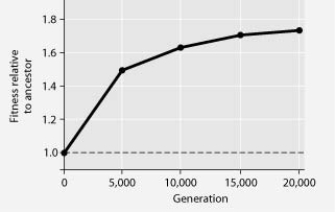In this eight-year experiment, 12 populations of E. coli, each begun from a single cell, were grown in low-glucose conditions for 20,000 generations. Each culture was introduced to fresh growth medium every 24 hours. Occasionally, samples were removed from the populations, and their fitness in low-glucose conditions was tested against that of members sampled from the ancestral (common ancestor) E. coli population. 
-E. coli cells typically make most of their ATP by metabolising glucose. Under the conditions of this experiment, E. coli generation times in the experimental lines and low-glucose conditions should ________.
Definitions:
Reagents
Chemicals or materials introduced into a system to initiate or participate in chemical reactions.
Transformation
A broad term indicating change, in chemistry often referring to the conversion of a compound into another by chemical reaction.
Structure
The arrangement of atoms or molecules in a compound, defining its chemical properties and behavior.
Product
The result of a process or chemical reaction, typically described in the context of what is synthesized or created.
Q3: Carolus Linnaeus believed that species remained fixed
Q13: What would be the most direct effect
Q20: Rank the following in order from most
Q23: What must be true of any organ
Q29: Using the data in the figure, how
Q31: Healthy corals are brightly coloured because they
Q54: Orchid seeds are tiny, with virtually no
Q55: The figure depicts the outline of a
Q59: <img src="https://d2lvgg3v3hfg70.cloudfront.net/TB6149/.jpg" alt=" Applying the principle
Q71: The advantages of seeds, compared to spores,